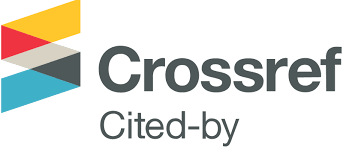Synthesis and the antimicrobial activity of precarbene and metalcarbene compounds of the imidazole series
DOI:
https://doi.org/10.24959/ophcj.14.790Keywords:
calixarenes, precarbene and metalcarbene compounds, antimicrobial activityAbstract
Precarbene and metalcarbene compounds of a series of imidazole have been synthesized to study their antimicrobial activity. Calix[4]arene imidazolium salts 3,4a,b have been obtained from the corresponding chloromethyl derivatives of calix[4]arenes and N-substituted imidazoles in dimethylformamide or tetrahydrofuran, and salt 5 – from p-xylylenediimidazoles and 1-bromoadamantane in o-dichlorobenzene. Monocarbene complexes of palladium 8a-c, copper(I) 8d and biscarbene complexes of nickel 9a and cobalt 9b have been synthesized by the direct interaction of stable carbenes with transition metal salts or by the analogous reactions in situ in tetrahydrofuran. The NMR spectra data of the compounds synthesized are given. The most characteristic signals of the carbenoid carbon atoms are detected in the 13С NMR spectra of complexes 8a-d, 9a in the range of 165-178 ppm. A high antimicrobial activity has been found for carbenoid salts 4a,b, 5 on the test-culture of M. Luteum. It corresponds to the minimal bacteriostatic concentration (MBsC) of 15.6 mkg/mL and the minimal bactericidal concentration (MBcC) of 62.5 mkg/mL for compound 2. The higher activity has been found for carbene complexes of nickel 9a and cobalt 9b on the test-culture of M. luteum (MBsC is 7.8 mkg/mL and MBcC is 15.6 mkg/mL), and the highest 9b on the test-cultures of M. luteum and C. tenuis (the minimal fungistatic concentration is 1.9 mkg/mL and the minimal fungicidal concentration is 3.9 mkg/mL).
Downloads
References
- Marichev К.A., Glinyanaya N.V., Korotkikh N.І., Shvaika О.P., Kiselyov А.V., Knishevitsky А.V., Pekhtereva Т.М., Dudarenko G.V., Komarovska-Porokhnyavets О.P., Novikov V.P., Lubenets V.І. Zhurnal organichnoi ta farmatsevtichnoi khimii – Journal of organic and pharmaceutical chemistry, 2011, Vol. 9, 3(35), pp.72-79.
- Korotkikh N.І., Shvaika О.P., Kiselyov А.V., Knishevitsky А.V., Glinyanaya N.V., Marichev К.A., Novikov V.P., Lubenets V.І., Iskiv О.P., Moskalenko N.I., Komarovska-Porokhnyavets О.P. Visnyk natsionalnogo universitetu „Lvivska polytekhnika” – Herald of National University “Lvivska polytekhnika”, 2008, 622, pp.3-6.
- Liu L., Huang Y., Riduan S.N., Gao S., Yang Y., Fan W., Zhang Y. Main-chain imidazolium oligomer material as a selective biomimetic antimicrobial agent (2012) Biomaterials, 33, pp.8625-8631. Cited 4 times. DOI: http://dx.doi.org/10.1016/j.biomaterials.2012.08.006
- Che C.-M., Sun R.W.-Y. Therapeutic applications of gold complexes: lipophilic gold(III) cations and gold(I) complexes for anti-cancer treatment (2011) Chem. Commun., Vol. 47, pp.9554-9560. Cited 37 times. DOI: 10.1039/c1cc10860c
- Oehninger L., Rubbiani R., Ott I. N-Heterocyclic carbene metal complexes in medicinal chemistry (2013) Dalton Trans., 42, 3269-3284. Cited 29 times. DOI:10.1039/c2dt32617e
- Gasser G., Metzler-Nolte N. The potential of organometallic complexes in medicinal chemistry (2012) Cur. Opinion Chem. Biol., 16, pp.84-91. Cited 45 times. DOI: 10.1016/j.cbpa.2012.01.013
- Liu W., Gust R. Metal N-heterocyclic carbene complexes as potential antitumor metallodrugs (2013) Chem. Soc. Rev., 42, 755. Cited 36 times. DOI: 10.1039/c2cs35314h
- John A., Ghosh P. Fascinating frontiers of N/O-functionalized N-heterocyclic carbene chemistry: from chemical catalysis to biomedical applications (2010) Dalton Trans., 39, pp.7183-7206. Cited 61 times. DOI: 10.1039/c002475a
- Hemmert C., Fabie A., Fabre A., Benoit-Vical F., Gornitzka H. Synthesis, structures, and antimalarial activities of some silver(I), gold(I) and gold(III) complexes involving N-heterocyclic carbene ligands (2013) Eur. J. Med. Chem. 60, 64-75. Cited 3 times. DOI: http://dx.doi.org/10.1016 /j.ejmech.2012.11.038
- Weaver J., Gaillard S., Toye C., Macpherson S., Nolan S.P., Riches A. Cytotoxicity of Gold(I) N-Heterocyclic Carbene Complexes Assessed by Using Human Tumor Cell Lines (2011) Chem. Eur. J., 17, pp.6620-6624. Cited 23 times.
- DOI: http://dx.doi.org/10.1016/j.ejmech.2012.11.038
- Yan J., Chow A.L.-F., Leung C.-H., Sun R.W.-Y., Ma D.-L., Che C.-M. Cyclometalated gold(III) complexes with N-heterocyclic carbene ligands as topoisomerase I poisons (2010) Chem. Commun., 46, pp.3893-3895. Cited 36 times. DOI: 10.1039/c001216e
- Синтезовано за методикою: Boyko V.I., Podoprigorina A.A., Yakovenko A.V., Pirozhenko V.V., Kalchenko V.I. Alkylation of narrow rim calix[4]arenes in a DMSO-NaOH medium (2004) J. Incl. Phenom. Macrocycl. Chem., 50, 193-197. Cited 8 times. DOI: 10.1007/s10847-005-5240-4
- Nagasaki T., Sisido K., Arimura T., Shinkai S. Novel conformational isomerism of water-soluble calix[4]arenes (1992) Tetrahedron, 48, pp.797-801. Cited 28 times. DOI: http://dx.doi.org/10.1016/S0040-4020(01)88184-9
- Strobel M., Kita-Tokarczyk K., Taubert A., Vebert C., Heiney P.A., Chami M., Meier W. Self-Assembly of Amphiphilic Calix[4]arenes in Aqueous Solution (2006) Adv. Funct. Mater., 16, 252-259. Cited 40 times. DOI: 10.1002/adfm.200500212
Downloads
Published
How to Cite
Issue
Section
License
Copyright (c) 2014 National University of Pharmacy

This work is licensed under a Creative Commons Attribution 4.0 International License.
Authors publishing their works in the Journal of Organic and Pharmaceutical Chemistry agree with the following terms:
1. Authors retain copyright and grant the journal the right of the first publication of the work under Creative Commons Attribution License allowing everyone to distribute and re-use the published material if proper citation of the original publication is given.
2. Authors are able to enter into separate, additional contractual arrangements for the non-exclusive distribution of the journal’s published version of the work (e.g., post it to an institutional repository or publish it in a book) providing proper citation of the original publication.
3. Authors are permitted and encouraged to post their work online (e.g. in institutional repositories or on authors’ personal websites) prior to and during the submission process, as it can lead to productive exchanges, as well as earlier and greater citation of published work (see The Effect of Open Access).












